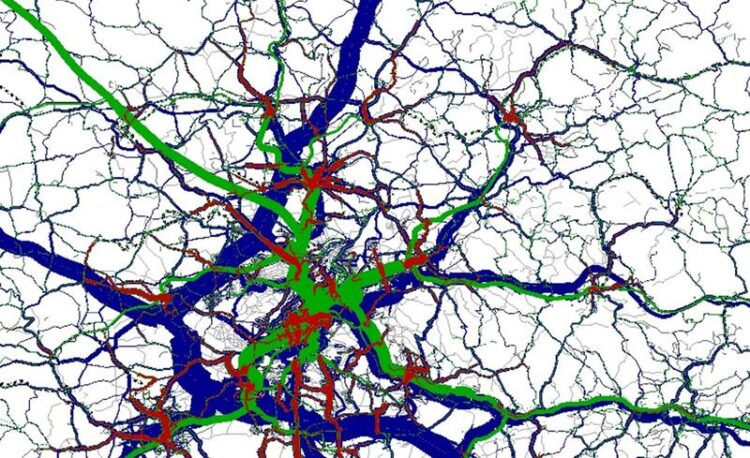A new model for more sustainable transport networks

The screenshot shows the traffic volume in a metropolitan region. Blue represents private transport, green represents public transport and red represents on-demand transport.
Credit: Professor Friedrich / University of Stuttgart
How to reduce emissions in the transport sector while maintaining our mobility?
“SynphOnie”, a research cluster funded by the German Federal Ministry of Education and Research (BMBF) that includes a team of researchers from the University of Passau headed by Professor Tobias Harks, is developing a mathematical model of transport flows to help make transport planning both needs-based and sustainable.
The transport sector is one of the biggest greenhouse gas emitters. To ensure adherence to the objectives of the Paris Agreement, transport planning needs to be innovative. Mathematical models can help to understand the complex interplay between the various modes of transport (passenger car and bicycle traffic, pedestrians, car sharing, local and long-distance public transport, commercial transport by trucks, freight trains, etc.) and to develop sustainable transport planning measures on the basis of such an understanding.
“SynphOnie” is a project coordinated by the University of Kaiserslautern-Landau and one of its missions is to model traffic flows in a metropolitan region. The research team includes mathematicians and enineers from the University of Passau, the University of Stuttgart and the Fraunhofer Institute for Industrial Mathematics (ITWM). “SynphOnie” is short for “Synergien aus physikalischen und verkehrsplanerischen Modellen zur multikriteriellen Optimierung multimodaler nachfrageorientierter Verkehre“ (Synergies from physical and transport-plan models for multi-criteria optimization of multimodal demand-driven transports).
“Our goal is to optimize complex multimodal transport systems by taking appropriate measures (transit lines and timetables, on-demand services, prices) in a multi-criteria approach so that that the two competing target variables emissions and travel times are both taken into account. One major mathematical challenge is that the optimization model must factor in the response of transport users to such measures and ensure that a new balance is found between supply and demand,” says Professor Tobias Harks, who holds the Chair of Mathematical Optimization at the University of Passau since October 2022. Under his supervision, the researchers in Passau develop a new model in order to balance traffic flow distributions among multimodal transport systems. The model will take into account the decision-making behaviour of all transport participants: When does someone decide to use the suburban rail line S-Bahn, when do they reach for the car keys? What options and preferences do they have when wanting to travel from point A to point B? In their work, Professor Harks and his team will be able to use the transport demand data for the Stuttgart region, which is one of the project’s backers.
The model will be used in the project in order to predict the effects of system changes, such as an additional railway route. For their part, the researchers hope this will allow them to identify infrastructure measures that will improve transport in terms of several target variables all at once, including travel time, capacity utilisation, costs and greenhouse gas emission.
The innovative nature of “SynphOnie” lies in its scope: While previous model approaches limited themselves to optimizing individual transport systems, this research cluster aims at developing an integrated model for multiple modes of transport.
The Federal Ministry of Education and Research (BMBF) has granted the project a three-year grant worth approx. EUR 1.3 million. Out of this pot, approx. 300,000 euros are earmarked for the University of Passau.
Wissenschaftliche Ansprechpartner:
Professor Tobias Harks
Chair of Mathematical Optimization
Dr.-Hans-Kapfinger-Str. 30
94032 Passau
E-Mail: Tobias.Harks@uni-passau.de
Media Contact
All latest news from the category: Ecology, The Environment and Conservation
This complex theme deals primarily with interactions between organisms and the environmental factors that impact them, but to a greater extent between individual inanimate environmental factors.
innovations-report offers informative reports and articles on topics such as climate protection, landscape conservation, ecological systems, wildlife and nature parks and ecosystem efficiency and balance.
Newest articles

Microscopic basis of a new form of quantum magnetism
Not all magnets are the same. When we think of magnetism, we often think of magnets that stick to a refrigerator’s door. For these types of magnets, the electronic interactions…

An epigenome editing toolkit to dissect the mechanisms of gene regulation
A study from the Hackett group at EMBL Rome led to the development of a powerful epigenetic editing technology, which unlocks the ability to precisely program chromatin modifications. Understanding how…

NASA selects UF mission to better track the Earth’s water and ice
NASA has selected a team of University of Florida aerospace engineers to pursue a groundbreaking $12 million mission aimed at improving the way we track changes in Earth’s structures, such…





















